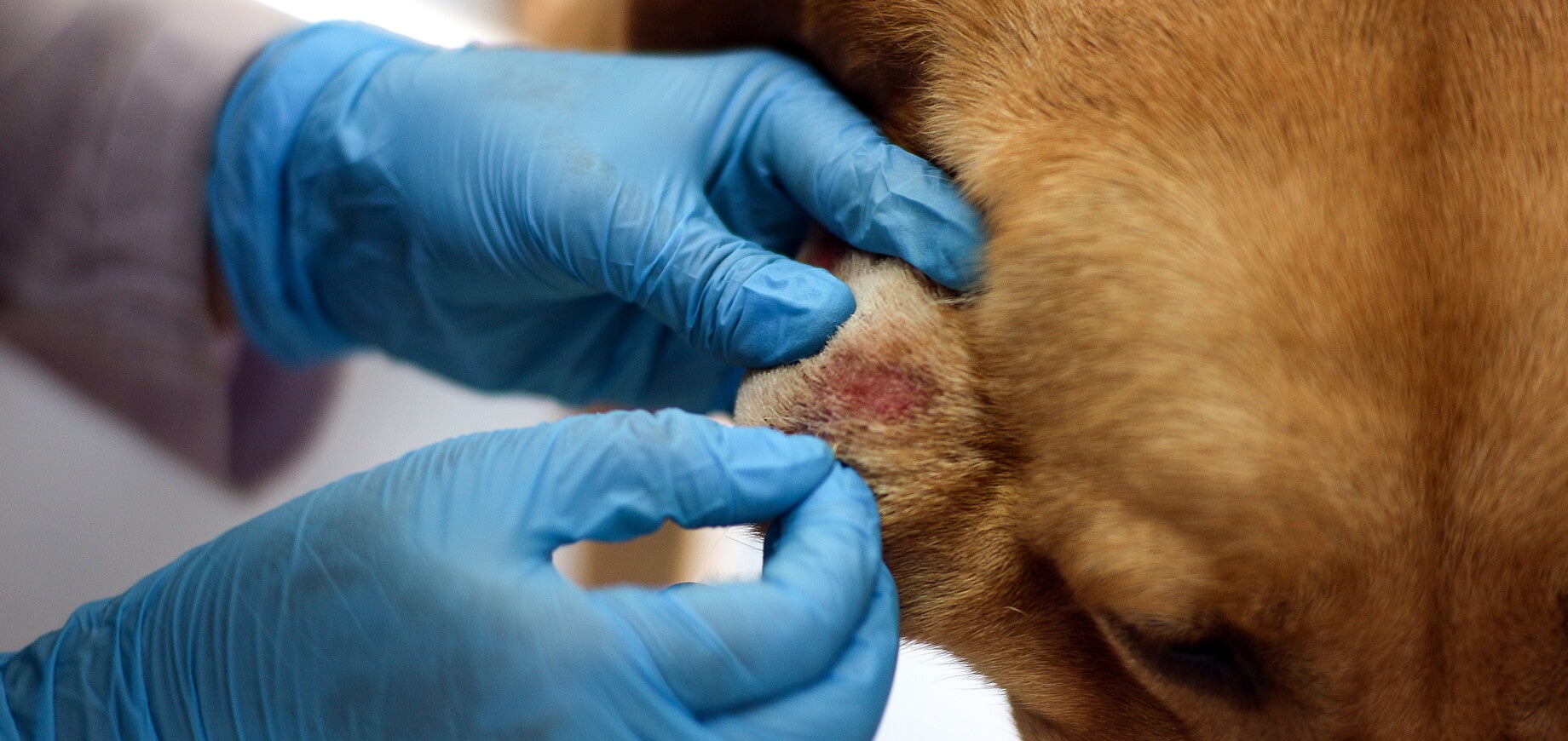Find products that match your dog’s needs

Ringworm in dogs is a common fungal infection that affects the skin, hair, and nails of our canine companions. Despite its name, ringworm is not a worm, but a collection of pathogenic fungi known as dermatophytes. Though not life threatening, ringworm can cause a lot of discomfort to your pooch. It can compel your dog to itch the affected areas. And as a dog parent, you don’t want to see your furry friend scratching inflamed areas with its paws, right? So, read on. This guide on ringworm in dogs helps you understand the symptoms, causes, and preventive measures of ringworm, allowing you to keep your dog healthy at all times.
Recognising the signs and symptoms of ringworm in dogs is essential for early diagnosis and treatment. Here are the common indicators to watch out for:
Circular patches of hair loss, especially on the face, ears, tail, and feet, are typical signs of ringworm in dogs. The hair loss areas often have a red, crusty edge.
Look for round, red, and crusty lesions. These circular patches are a hallmark of ringworm and are often accompanied by broken hair.
Dry, scaly skin or areas with excessive dandruff can indicate a ringworm infection. The skin may appear flaky and rough.
Inflamed or darkened patches of skin are common symptoms. The areas may be tender and sensitive to the touch.
Dogs with ringworm often experience itchiness, leading to scratching, excessive grooming, and even inflamed nail beds. Watch for changes in nail appearance, such as darkened, dry, or brittle nails.
Dogs with weaker immune systems, such as puppies, senior dogs, and those with chronic conditions, are more susceptible to ringworm. And breeds like Boston Terriers, Yorkshire Terriers, and Russell Terriers are genetically predisposed to the infection. However, any dog can get ringworm disease due to any of the following reasons:
Ringworm is generally caused by pathogenic fungi, primarily Microsporum canis. These fungi thrive on the outermost layer of the skin and hair follicles.
Dogs can contract ringworm through direct contact with an infected animal or human. Even asymptomatic dogs can spread the infection.
Ringworm spores can survive on objects like brushes, dog beds, toys, and surfaces such as rugs, wool, and wood. Dogs can pick up the spores from these contaminated items.
Poor hygiene and skin conditions like open wounds, scratches, or flea infestations also increase the risk.
Preventing ringworm in dogs requires you to maintain a healthy environment. Here are some effective strategies:
Regular grooming helps to keep your dog's skin and coat healthy, removing dirt, debris, and potential fungal spores. Use clean grooming tools to prevent the spread of ringworm.
Maintain proper hygiene by regularly washing your dog's bedding, toys, and grooming tools. Disinfect common areas of your home where your dog spends time to minimise the risk of contamination.
Regularly vacuum your home to remove hair and skin cells that may harbour ringworm spores. Pay special attention to carpets, rugs, and furniture. Use pet-safe disinfectants to clean surfaces.
Limit your dog's exposure to other animals that may be infected with ringworm. This is particularly important in multi-pet households, shelters, or kennels where infections can spread easily.
Schedule regular veterinary check-ups to monitor your dog's overall health. Early detection of ringworm symptoms in dogs allows for prompt treatment and reduces the risk of spreading the infection.
A balanced, nutritious diet strengthens your dog's immune system, making them less susceptible to infections, including ringworm. So, make sure that you opt for dog food that is nutritionally balanced and complete.
Treating ringworm in dogs involves a combination of topical and oral treatments as well as thorough environmental cleaning for complete eradication. Here are some effective methods:
Bathing your dog with antifungal shampoos is a critical part of the treatment process. These shampoos help remove and kill fungal spores on your dog's fur, preventing further contamination. But, always go for the shampoo that is recommended by a vet.
Lime sulfur dips are highly effective and can be done at home or at a vet's office. Although messy and odourous, they are excellent at combating ringworm. These dips should be performed under veterinary guidance to ensure proper application.
For localised infections, antifungal creams and ointments can be applied directly to the affected areas. These treatments help reduce the contagiousness of the ringworm patch.
Note: Shaving dogs with long coats is not recommended as it can cause microtrauma to the skin, making the dog more susceptible to infection.
These medications work by inhibiting the fungus' ability to reproduce and spread. Your veterinarian will prescribe the most suitable medication based on your dog's health and specific diagnosis. Follow your vet’s instructions carefully for your pet’s speedy recovery.
Environmental cleaning is necessary for getting rid of this fungal infection. Here are a few things you must do to treat ringworm in dogs:
Isolate your infected dog in an easily cleanable room, such as a bathroom. This will help prevent the spread of ringworm to other pets and humans. Avoid rooms with rugs or wood floors, as these are difficult to disinfect.
Vacuum your home frequently to remove hair and skin cells that may harbour ringworm spores. Use pet-safe disinfectants to clean surfaces. Items like dog beds should be laundered twice in hot water with bleach.
Clean all areas your dog has contacted with an effective disinfectant, such as accelerated hydrogen peroxide. Clean first with an agent like liquid dish soap, then disinfect.
Always wear disposable gloves and wash your hands and clothing after handling an infected pet. This reduces the risk of spreading the infection to yourself and other household members.
By maintaining a clean environment and following veterinary guidance, you can effectively manage and prevent ringworm infections. So, make sure you identify the early signs of ringworm in dogs and consult a vet at the earliest.
Ringworm in dogs is a fungal infection affecting the skin, hair, and nails, characterised by circular patches of hair loss and red, crusty edges. Despite its name, it’s not a worm but a highly contagious fungus.
Common ringworm symptoms in dogs include hair loss, circular patches, scaly skin, red or inflamed skin, and excessive itching or scratching. Early detection is key for effective ringworm treatment for dogs.
Yes, ringworm in dogs is contagious to humans. It is a zoonotic infection, meaning it can spread from animals to humans through direct contact with an infected dog or contaminated objects.
The recovery time for ringworm in dogs typically ranges from 2 to 6 weeks, depending on the severity of the infection and the effectiveness of the treatment plan, including topical and oral medications.

Find a PEDIGREE® stockist
near you!
Buy online
Click to buy from any of the retailers below

